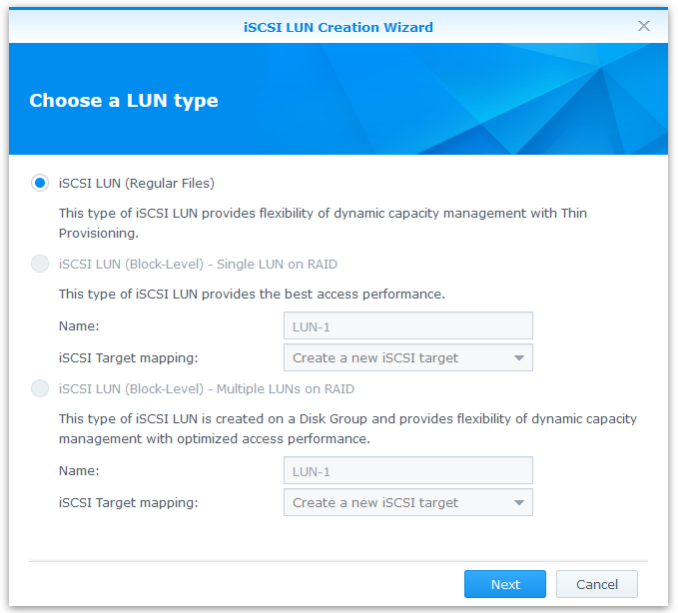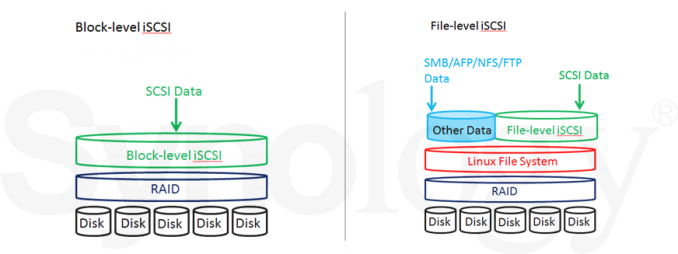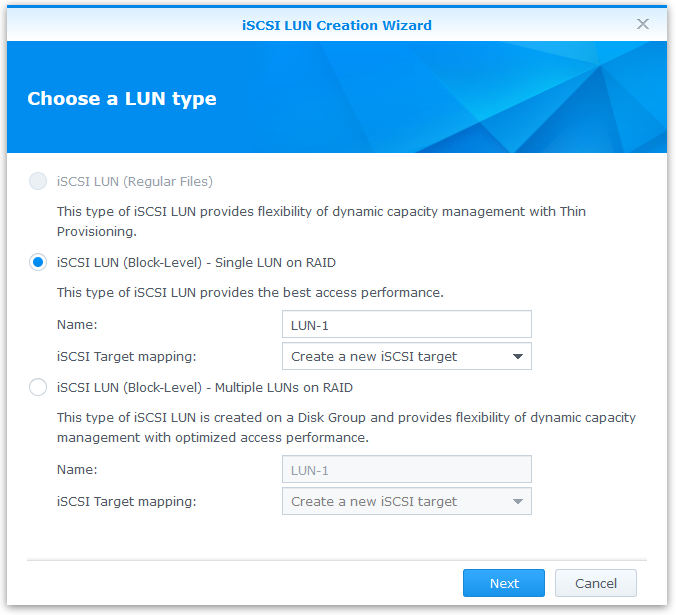ioSafe 1513+ Review: A Disaster-Resistant Synology DS1513+
by Ganesh T S on August 13, 2014 7:30 AM EST- Posted in
- NAS
- Storage
- Synology
- Enterprise
- ioSafe
DSM 5.0: iSCSI Features
Synology's DSM is quite feature rich, and it is impossible to do it justice in a single review. Starting with the DS214play, we decided to use each review to focus on one particular aspect of the DSM / firmware ecosystem. The DS214play review dealt with the media aspects and associated apps and the DS414j review explored the backup and synchronization infrastructure. With its Atom-based platform, comparatively large amount of RAM and four network links, we decided that the ioSafe 1513+ was the perfect candidate to explore the iSCSI features of Synology DSM 5.0
Background
Readers dabbling in virtualization would be quite familiar with iSCSI and can conveniently skip this sub-section to move on to the discussion of Synology's iSCSI features further down. In layman's terms, iSCSI is a protocol which allows storage on a networked device to be presented as a physical device on another machine. Readers wanting to go into further detail on the various aspects of iSCSI can refer to Wikipedia.
iSCSI has been attracting a lot of interest from NAS vendors in the recent past due to the rising popularity of virtualized infrastructure. Since iSCSI devices appear as physical drives on the machines in which they are mapped, they are ideal for virtual machine hosts. The mapped iSCSI drives can be used as physical disks for the guest machines or simply as a store for the virtual hard disk files mapped to the guests.
In order to understand iSCSI implementations, it is important to be aware of two concepts, the LUN and the target. The LUN (Logical Unit Number) refers to a device that can be addressed via SCSI protocols and supports read/write operations. On the other hand, a target is an endpoint in the SCSI system to which an initiator (or master) connects. A target without a LUN is essentially useless, as there is nothing that be read or written. A target can have one or more LUNs associated with it.
Source: VMWare
In simple setups, each target is associated with a single LUN. If there are multiple LUNs associated with a target, each of them will appear as a separate physical disk for the initiator connecting to the target. In the rest of this coverage, we will be proceeding with the single LUN on single target configuration.
Synology's iSCSI Implementation
Synology has a step-by-step guide to get iSCSI services up and running on DSM. In this section, we share our experience and configurations steps with the ioSafe 1513+. After completing all the benchmarks in the previous section, we were left with a SHR volume (1-disk fault tolerance) having a few shared folders. Upon proceeding to create an iSCSI LUN, we were presented with three choices, two of which were grayed out. The only available option was to create a iSCSI LUN (Regular Files).
File-Based LUNs
Synology implements iSCSI LUN (Regular Files) as files under the path "/volume1/@iSCSITrg/". As seen from the above screenshot, Synology touts the dynamic capacity management using Thin Provisioning as the most advantageous aspect. Trying to create such a LUN rightly exposes an option for 'Thin Provisioning'. Enabling this allows for capacity expansion at a later stage.
The ioSafe 1513+ carries virtualization logos in its marketing collateral ("VMware READY", "CITRIX ready" and "Windows Server 2012 Certified"). Synology NAS units carrying these logos have an option for 'Advanced LUN Features' that can be turned on or off. If enabled, VMware VAAI - vStorage APIs for Array Integration - support is reported back to the initiator. This offloads storage tasks such as thin provisioning and cloning of virtual disks from the VM host to the NAS itself. On the Windows side, the advanced LUN features include ODX - Offloaded Data Transfers - for data transfer to not clog up the network bandwidth if possible (i.e, data movement from one part of the NAS volume to another) as well as LUN snapshotting and cloning.
Block-Level LUNs
Instead of file-based LUNs, users can also create block-based ones. Synology sums up the implementation difference succinctly in this graphic:
The trick to enable creation of block-based LUNs is to avoid the auto-creation of a SHR volume (or any other RAID volume) when the NAS gets initialized in the beginning. If such volumes exist, it is necessary to remove them. Once all volumes are removed, we can see the two previously-grayed out options getting enabled.
There are two ways to proceed with either of these two options. One is to follow the directions given in the LUN creation wizard and make it automatically create a Disk Group in a particular RAID configuration. The other is to create a disk group beforehand and use it while initializing the new LUN. Note that SHR is not available for such groups.
Choosing the Single LUN on RAID option utilizes the full capacity of all the disks in the Disk Group to a single target with one LUN. Such a LUN could potentially be mapped on a VM host and multiple virtual hard disk files could be create on it. Synology indicates that this configuration provides the best performance.
On the other hand, the Multiple LUNs on RAID option allows for specification of LUN size during creation. Synology claims this provides optimized performance. The advantage is that multiple LUNs can be created to map on as separate physical drives for multiple VMs. The left-over space can be used for the creation of a standard volume on which one can have the usual CIFS / NFS shares. An important aspect to note is that the VAAI and ODX capabilities are not available for block-level LUNs, but only for the regular file-based ones.
In the next section, we deal with our benchmarking methodology and performance numbers for various iSCSI configurations in the ioSafe 1513+.































43 Comments
View All Comments
ganeshts - Wednesday, August 13, 2014 - link
I hope we don't have readers chiming in about how they can build a better DIY NAS than the one presented here :)hodakaracer96 - Wednesday, August 13, 2014 - link
I for one, was hoping for fire and water testing :)Samus - Wednesday, August 13, 2014 - link
Some good "tests" on youtube:https://www.youtube.com/watch?v=qm4J_1jFxik
https://www.youtube.com/watch?v=yszTblXpwgY
ddriver - Thursday, August 14, 2014 - link
I wouldn't bet money on this product surviving an actual fire. Insulation seems too thinganeshts - Friday, August 15, 2014 - link
I hope you are kidding :) ioSafe's products have been proven to work - they have many real world success stories. Quite sure they can't have big-name customers if they don't prove that they can really protect the drives as per the disaster specifications quoted. Just for reference, a picture of one of the 1513+ units subject to both fire and water damage is in our CES coverage: http://www.anandtech.com/show/7684/synology-dsm-50...ddriver - Friday, August 15, 2014 - link
Well, looking at the youtube videos of fire test I am not really impressed. Surely, it will probably survive a mild and short fire with not much material to burn, but being in a serious blaze and buried in blowing embers it will not last long. A regular NAS unit put in a small concrete cellar with no flammable materials in it has better chances of surviving.And this probably has to do with how they test their products, which I can logically assume is safe controlled fires carefully estimated to not exceed the theoretical damage the unit can handle. But how many houses did they torch to test their products in real life disaster situations? My guess is zero :)
ddriver - Friday, August 15, 2014 - link
I mean, it will most likely survive a plastic trash can full of paper catching fire and burning out next to it, but will it survive an actual blaze disaster? I highly doubt it.In other words, I don't doubt the product will survive what they claim it can survive, I doubt that the disaster specifications they quote reflect real world fire disasters well enough. They will probably suffice for "fire accidents" but not really in "fire disasters".
ganeshts - Friday, August 15, 2014 - link
Does this convince you?http://geardiary.com/2009/08/04/could-your-hard-dr...
As for real-life situations, they are claiming protection for the following fire situation: 1550°F, 30 minutes per ASTM E-119
I remember reading a post about some statistics regarding how fast fire services respond to hourhold fires, and ioSafe's protection circumstances fall within that. Anyways, this product is targeted at SMBs / SMEs who have buildings as per fire marshal codes. Any blaze in such a situation is probably going to be controlled well by building sprinklers.
ddriver - Friday, August 15, 2014 - link
It is the 1550 F number that bothers me. That's below 850 C, and even wood and plastic burns at almost 2000 C using air as oxidizer. Most of the stuff that is flammable burns around 1950 C, so targeting the product at 850 C pretty much excludes direct fire damage. E.g. if you have a wooden cabin and if it burns to the ground, the data is very unlikely to recover.That is why I drew a line between "accident" and "disaster". This product will do in the case of fire accidents, but in the case of a fire disaster its specs are just not enough.
So, it is a "fireproof" product for buildings with anti-fire sprinkler installations and with good accessibility for fire services. In short, it doesn't protect in the case of fire disasters, but in the case of fire accidents and the water used to put them out.
robb.moore - Friday, August 15, 2014 - link
Hi ddriver-The average cellulose building fire temps are between 800-1000F for about 10-15 minutes. We've been in many fires and have a record or zero data loss for fire disasters in the real world. Most of the building damage is actually caused by firefighter hoses - not the actual fire. The absolute temperature (1500, 1700, 2000...) is not as important as the duration actually. Think of a pot of water boiling on the stove - as long as there's water in the pot, the pot doesn't melt because the endothermic action of the boiling water (212F) keeps the pot from melting. The flame temp could be anywhere between 800 and 3000+? and the water would still boil at 212F (assuming sea level pressures). You could use an aluminum pot (which melts at 1100) and still be ok. Once the water runs dry, then you'll ruin the pot. It's actually the same with all fire safes (and ioSafe). There's water chemically bound to the insulation that works to cool the inner chamber and keeps it at survival temps. Our fire test standards is hotter and longer than typical building fires and the systems we sell typically can go double the standard just to be conservative.
The fire protection technology is not new. We use the same proven techniques that have been around for 100 years. What unique about ioSafe is how we combine fire/water protection with active computers – managing the heat produced during normal operation while protecting against extreme heat possible during a disaster.
As Ganesh has said, we test both internally and externally (with the press watching and recording!) in both standard and (ahem) very non-standard ways at times - we've NEVER failed a demo. One of these days, I'm sure a gremlin's gonna pop up and we'll get recorded by the press as failing a disaster demo (because a HDD refuses to boot) but that's the risk we take. Our stuff's legit.
And btw, a cellar is a great place for tornados and fires but not so good for water main breaks or river floods – we’ve seen it all :)
Robb Moore, CEO
ioSafe Inc.